Detroit River-Western Lake Erie Basin Indicator Project
Fall Raptor Migration at Holiday Beach Conservation Area, Amherstburg, Ontario, Canada
Background
Fall migrating birds have used the north shore of Lake Erie since the last ice sheet retreated. Since the 1950s casual observers have recorded large numbers of hawks at Holiday Beach Conservation Area (HBCA) east of Amherstburg, Ontario, Canada and nearby sites. More systematic observations began in the 1970s, when evidence indicated that hawks and other birds were experiencing dramatic population declines. Over two million raptors have been counted at this site during the past 35 years.
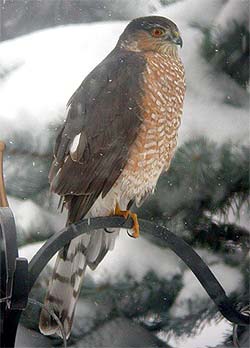
Sharp-shinned hawk (Accipiter striatus) (Photo Credit: Bill Schmoker).
Since 1974, from September through November, qualified volunteer observers, members of Holiday Beach Migration Observatory (HBMO), have worked enthusiastically (600 hours seasonal average) toward a goal of identifying and recording all migrant raptors passing the count site. The information collected is analyzed locally in cooperation with Hawk Migration Association of North America (HMANA) (Chartier and Stimac, 2002). HMANA was organized to help standardize count procedures and identification, and to educate the public. Currently, HMANA is assessing the wellbeing of raptor populations with data collected at several well-established raptor sites, including HBCA.
Since birds of prey are indicators of ecosystem health, due to their terminal position in the food web, any decline in their number might indicate unfavorable environmental conditions. Because raptors are top carnivores in short food webs they are usually the first wild species to show ill effects of bioaccumulated contaminants in the watersheds. Historically these contaminants included heavy metals and chlorine-based pesticides (DDT, aldrin, dieldrin, and heptachlor). In several species of raptors these accumulated materials have contributed to reproductive failure, eggshell thinning, bill malformations, nesting failure, and death.
Raptors depend on updrafts of warming air, primarily over land, for gliding and soaring. As the raptors move south from their eastern Canadian breeding areas, the north shores of Lakes Erie and Ontario become migration barriers. The birds are forced to follow the Lake Erie shoreline westward and are funneled into a narrow migration avenue with Lakes St. Clair and Huron bordering to the north. The birds are able to cross the Big Creek marsh west of the Holiday Beach count site and cross the Detroit River on their flight southwestward (Figure 1). After crossing the Detroit River a majority of the birds are recounted by observers (Southeastern Michigan Raptor Research, SMRR) located at Lake Erie Metropark and Point Mouillee.
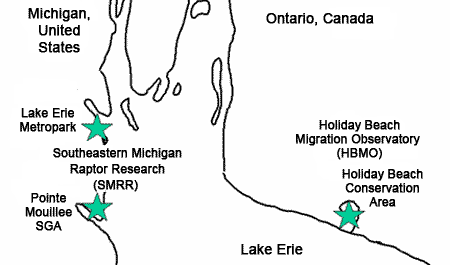
Figure 1. Count site locations at Holiday Beach Migration Observatory (HBMO) and Southeastern Michigan Raptor Research (SMRR)
Status and Trends
Each fall at HBCA, observers tally between 600,000 and 750,000 migrant birds from ducks to warblers, with an average of 75,000 of these being hawks. Because of these large numbers of fall migrants using this region for their trek southward, HBCA has received the status of an Important Bird Area by National Audubon Society. Birds in the area generally start flying at sunrise and continue throughout the day. The biggest factor influencing whether a bird will be counted is wind direction. North component winds (NNW, NW, N, NE, NNE) force the birds to follow more closely to the north shore of the lake and therefore within range of being counted. South component winds tend to move the birds more north of the count site out of range of viewing and therefore are not counted. Consequently, there may be large variations in total numbers within a species from year to year, however, over a long period these differences are minimal. Analysis of population trends must take into account this wind-influencing factor.
Figure 2 illustrates an upward trend of red-shouldered hawks from the mid-1970s through the early 1990s, followed by a decline through 2004. The low numbers observed in recent years are due to the decreased percentage of immature birds. The cause or causes of this very poor production and survival is unknown and likely requires research on their nesting grounds.
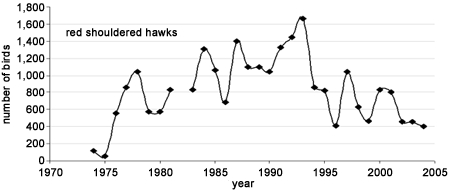
Figure 2. Red-shouldered hawk trend data from Holiday Beach, 1974-2004 (no data available for 1982).
Figure 3 shows a dramatic increase in turkey vulture numbers (HBMO). A similar increase was also observed at the U.S. sites operated by SMRR. In recent years, this species has continuously had record numbers each season. In 2004, the turkey vulture count was 86% higher then the 1974 count at HBCA and in 2005 a record number of 41,500 vultures were sighted. All but one hawk watch site within the Central Continental Flyway have recorded increases in turkey vulture sightings (Berardi 2004).
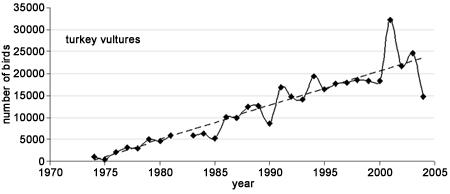
Figure 3. Turkey vulture trend data from Holiday Beach, 1974-2004 (no data available for 1982).
Figure 4 illustrates increases in numbers of peregrine falcons, osprey, and bald eagles during the 30-year period, 1974-2004 (HBMO). Hawk watches throughout the Central Continental Flyway have also noted a similar increase (Berardi 2004). In 2004, osprey and peregrine falcon were below their 10 year averages by 27% and 30%, respectively. The bald eagle totals in 2004 were approximately equal to their 10-year average.
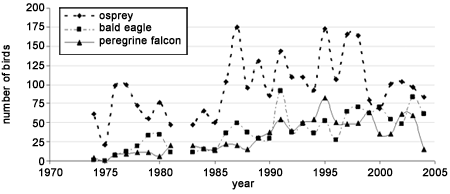
Figure 4. Osprey, bald eagle, and peregrine falcon trend data from Holiday Beach, 1974-2004 (no data available for 1982).
The sharp-shinned hawk is the most consistently observed raptor during the 92 days of the fall count season. Excluding days with severe weather (very high winds, thunderstorms, and driving rain), sharp-shinned hawks are recorded on 98% of the remaining count days. Yearly totals for this species are decreasing with 2004 being a record low count year (Figure 5). Even though wind direction does influence count totals, there is a real declining trend in sharp-shin numbers. This trend is recorded at many of the eastern count sites. Two factors are thought to contribute to this decline. One is the possible reduction in prey species in their breeding range, since fall numbers reflect nesting success. The second factor is speculation that pesticide usage on their wintering areas in Central America is altering their reproductive success.
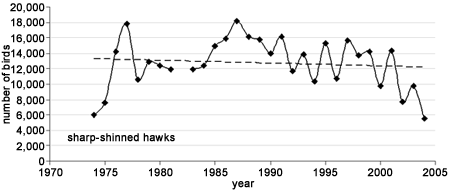
Figure 5. Sharp-shinned hawk trend data from Holiday Beach, 1974-2004 (no data available for 1982).
Management Next Steps
Reaching a goal of sustainable raptor populations in the northern Great Lakes will require increasing the carrying capacity by improving the amount of foraging and nesting habitats through conservation and restoration. Red-shouldered hawk management may require conservation and restoration of their preferred habitats of damp woods, river bottomlands, and swamps with tall trees where birds can nest 20-60 feet above ground. Perches with a wide field of view could be constructed to assist the birds to hunt prey such as rodents, birds, frogs, and snakes live (Fergus 2004).
Research/Monitoring Needs
Monitoring consistently during fall migration should continue. Each year procedures and guidelines should be reviewed and updated. Improvements to the existing program should include more funding for paid staff (counters and banders), more educational opportunities for volunteers to maintain high standards of data collection, and more public outreach. Additional research efforts during the breeding season in north and northeastern Ontario, Canada could explain trends in population fluctuations (in particular, the red-shouldered hawk adult/immature ratios). Using radio tagged birds would broaden our knowledge of specific species' migration habits. Increasing the number of raptor count sites would also help to give a broader picture of the scope of raptor migration and ultimately a more realistic view of their numbers.
Well-funded studies of the blood chemistry of migrating sharp-shinned hawks during their fall and spring passage need to be conducted to determine what foreign chemicals might be influencing reproduction success. Obtaining samples at both times of the year could show differences in the period of accumulation of any foreign material.
References
- Berardi, V. 2004. Fall 2003 Central Continental Flyway Report, August 2004. HMANA Hawk Migration Studies Vol. XXIX No. 1.
- Chartier, A. and D. Stimac. 2002. Hawks of Holiday Beach: A Guide to their Identification, Occurrence, and Habits at Holiday Beach Conservation Area, Ontario, Canada, 2nd Edition. pp. 3-8.
- Fergus, C. 2004. Pennsylvania Game Commission, Wildlife Notes.
Contact Information regarding Fall Raptor Migration at Holiday Beach Conservation Area, Amherstburg, Ontario, Canada
Bob Hall-Brooks, President
Holiday Beach Migration ObservatoryE-mail: Bhall-brooks@cogeco.ca
Jason Sodergren, Secretary and Raptor Co-Chair
Holiday Beach Migration ObservatoryE-mail: Jason@taiga.com
Bob Pettit, U.S. Vice President and Raptor Co-Chair
Holiday Beach Migration ObservatoryE-mail: redknot@earthlink.net